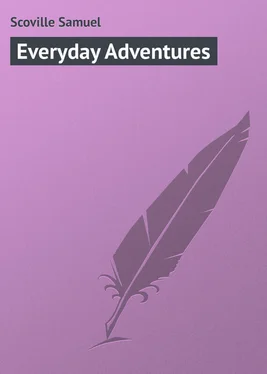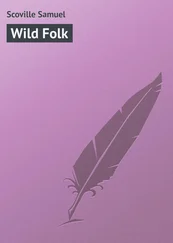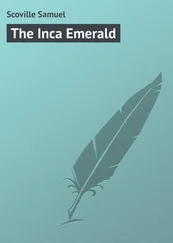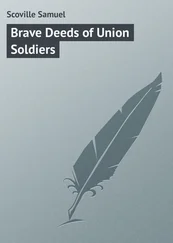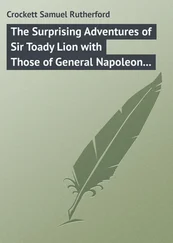Samuel Scoville - Everyday Adventures
Здесь есть возможность читать онлайн «Samuel Scoville - Everyday Adventures» — ознакомительный отрывок электронной книги совершенно бесплатно, а после прочтения отрывка купить полную версию. В некоторых случаях можно слушать аудио, скачать через торрент в формате fb2 и присутствует краткое содержание. Жанр: foreign_prose, foreign_language, на английском языке. Описание произведения, (предисловие) а так же отзывы посетителей доступны на портале библиотеки ЛибКат.
- Название:Everyday Adventures
- Автор:
- Жанр:
- Год:неизвестен
- ISBN:нет данных
- Рейтинг книги:3 / 5. Голосов: 1
-
Избранное:Добавить в избранное
- Отзывы:
-
Ваша оценка:
- 60
- 1
- 2
- 3
- 4
- 5
Everyday Adventures: краткое содержание, описание и аннотация
Предлагаем к чтению аннотацию, описание, краткое содержание или предисловие (зависит от того, что написал сам автор книги «Everyday Adventures»). Если вы не нашли необходимую информацию о книге — напишите в комментариях, мы постараемся отыскать её.
Everyday Adventures — читать онлайн ознакомительный отрывок
Ниже представлен текст книги, разбитый по страницам. Система сохранения места последней прочитанной страницы, позволяет с удобством читать онлайн бесплатно книгу «Everyday Adventures», без необходимости каждый раз заново искать на чём Вы остановились. Поставьте закладку, и сможете в любой момент перейти на страницу, на которой закончили чтение.
Интервал:
Закладка:
At this point another character was added to the plot of this snow story. Approaching at right angles to the trail of the skunk were the tracks of a red fox. I knew he was red, because that is the only kind of fox found in that part of New England. I knew them to be the tracks of a fox, because they ran straight instead of spraddling like a dog, and never showed any mark of a dragging foot. The trail told what had happened. The first tracks were the far-apart ones of a hunting fox. When he reached the skunk’s trail, the foot-prints became close together and ran parallel to the trail and some distance away from it. The fox was evidently following the tracks in a thoughtful mood. He was a young fox, or he would not have followed them at all. At the edge of the clearing he had sighted the skunk and stopped, for the prints were melted deep into the snow. Sometimes an old and hungry fox will kill a skunk. In order to do this safely, the spine of the skunk must be broken instantly by a single pounce, thus paralyzing the muscles on which the skunk depends for his defense; for the skunk invented the gas-attack a million years before the Boche. No living animal can stay within range of the choking fumes of the liquid musk which the skunk can throw for a distance of several feet. The snow told me what happened next. It was a sad story. The fox had sprung and landed beside the skunk, intending to snap it up like a rabbit. The skunk snapped first. Around the log was a tangle of fox-tracks, with flurries and ridges and holes in the snow where the fox had rolled and burrowed. Out of the farther side a series of tremendous bounds showed where a wiser and a smellier fox had departed from that skunk with an initial velocity of close to one mile per minute. Finally, out of the confused circle came the neat, methodical trail of the unruffled skunk as he moved sedately away. Probably to the end of his life the device of a black-and-white tail rampant will always be associated in that fox’s mind with the useful maxim, “Mind your own business.”
Beyond the instructive fable of the fox and the skunk showed lace-work patterns and traceries in the snow where scores and hundreds of the mice-folk had come up from their tunnels beneath the whiteness, and had frolicked and feasted the long night through. Some of these tracks were in little clumps of fours. Each group had a five-fingered pair of large prints in front and a pair of four-fingered tracks just behind. Down the middle ran a tail-mark. They were the tracks of the white-footed or deer-mice. These were the same little robbers which swarmed into my winter camp and gnawed everything in sight. Even a flitch of bacon hung on a cord was riddled with their tiny teeth-marks. Only things hung on wires were safe, for their clinging little feet cannot find a footing on the naked iron. One night they gnawed a ring of round holes through the crown of a cherished felt hat belonging to a friend of mine. The language he used when he looked at that hat the next morning was unfit for the ears of any young deer-mouse. Another time the deer-mice carried off about a peck of expensive stuffing from a white horse-hair mattress, which I had imported for the personal repose of my aged frame. Although I ransacked that cabin from turret to foundation-stone I could never find a trace of that horse-hair. In spite of their evil ways one cannot help liking the little rascals. They have such bright, black eyes, and wear such snowy, silky waistcoats and stockings.
The other evening I sat reading alone in my cabin in the heart of the pine-barrens before a roaring fire. Suddenly I felt something tickle my knee. When I moved there was a sudden jump and a deer-mouse sprang out from my trouser-leg to the floor. Then I put a piece of bread on the edge of the wood-box. Although I saw the bread disappear, I could catch no glimpse of what took it. Finally I put a piece on my shoe, and after running back and forth from the wood-box several times, Mr. Mouse at last became brave enough to take it. When he found that I did not move, he sat up on my shoe like a little squirrel and nibbled away at his crumb, watching me all the time out of a corner of his black eyes. I forgave him my friend’s hat, and was almost ready to overlook the horse-hair episode. When I moved, like a flash he dashed up the wall by the fireplace, and hid behind a row of books that stood on the red-oak plank which I had put in as a mantel-piece. Unfortunately he had forgotten to hide his long silky tail. It hung down through the crack between the plank and the rough stone of the chimney. I tiptoed over and gave it a pinch to remind him to meddle no more with other people’s mattresses.
Returning to the wood-road – on that morning, among the trails of the deer-mice were the more numerous tracks of the meadow- or field-mouse. They show no tail-mark, and the smaller footprints were not side by side as with the deer-mice, but almost always one behind the other. These smaller paw-marks among all jumping-animals, such as rabbits, squirrels, and mice, are always the marks of the fore-paws. The larger far-apart tracks mark where the hind feet of the jumper come down in front and outside of the fore-paws as he jumps.
On that day, among the mouse-tracks on the snow there showed another faint trail, which looked like a string of tiny exclamation marks with a tail-mark between them. It was the track of the masked shrew, the smallest mammal of the Eastern states. This tiny fierce fragment of flesh and blood is only about the length of a man’s little finger. So swift are the functions of its wee body that, deprived of food for six hours, the shrew starves and dies. Many of them are found starved to death on the melting snow, having crept up from their underground burrows through the shafts made by grass and weed-stems. Wandering over the white waste, they lose their way and, failing to find food, starve before the sun is half way down the sky. As the shrew does not hibernate, his whole life is a swift hunt for food; for every day this apparently eyeless, earless animal must eat its own weight in flesh. The weasels kill from blood-lust, but the shrews kill for their very life’s sake. It is a fearsome sight to see a shrew attack a mouse. The mouse bites. The shrew eats. Boring in, the shrew secures a grip with its long, crooked, crocodile jaws filled with fierce teeth, and devours its way like fire through skin and flesh and bone, worrying out and swallowing mouthfuls of blood and flesh until the mouse falls over dead. This tiny beastling, the masked shrew, must be weighed by troy weight, and tips a jeweler’s scale at less than forty-five grains.
To-day the snow said the shrew had been an unbidden and unwelcome guest at the mice-dinner. At first the mice-trails were massed together in a maze of tracks. Where the trail of the shrew touched the circle, there shot out separate lines of mice-tracks, like the spokes of a wheel, with the paw-marks far apart, showing that the guests had all sprung up from the laden table of the snow and dashed off in different directions. The shrew-track circled faintly here and there, ran for some distance in a long straight trail, and – stopped. The Sword of Damocles, which hangs forever over the head of all the little wild-folk, had fallen. The shrew was gone. A tiny fleck of blood and a single track like a great X on the snow told the tale of his passing. All his fierceness and courage availed nothing when the great talons of the flying death clamped through his soft fur. X is the signature of the owl-folk just as K is of the hawk-kind. The size of the mark in this case showed that the killer was one of the larger owls. Later in the winter it might have been the grim white Arctic owl, which sometimes comes down from the frozen North in very cold weather. So early in the season, however, it would be either the barred or the great horned owl.
Читать дальшеИнтервал:
Закладка:
Похожие книги на «Everyday Adventures»
Представляем Вашему вниманию похожие книги на «Everyday Adventures» списком для выбора. Мы отобрали схожую по названию и смыслу литературу в надежде предоставить читателям больше вариантов отыскать новые, интересные, ещё непрочитанные произведения.
Обсуждение, отзывы о книге «Everyday Adventures» и просто собственные мнения читателей. Оставьте ваши комментарии, напишите, что Вы думаете о произведении, его смысле или главных героях. Укажите что конкретно понравилось, а что нет, и почему Вы так считаете.
